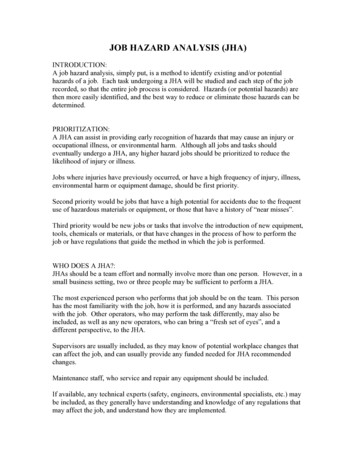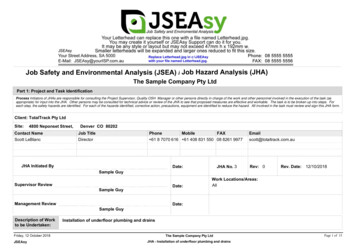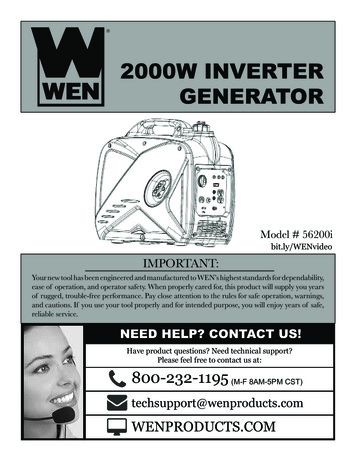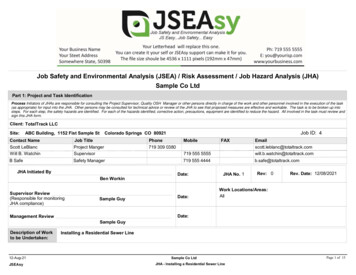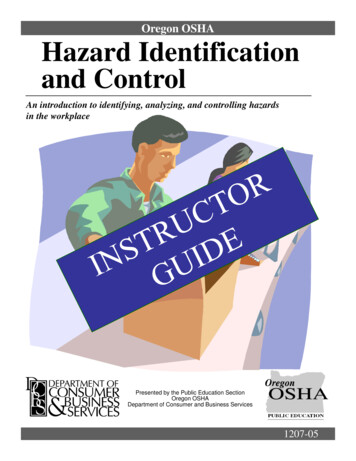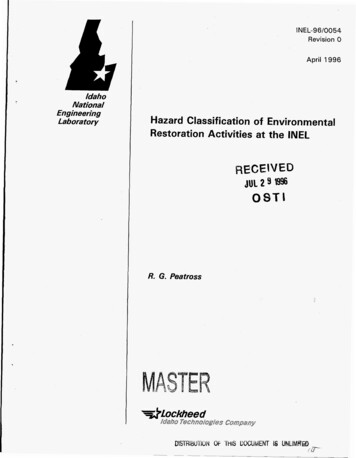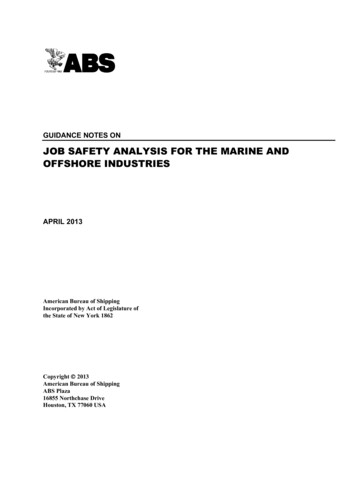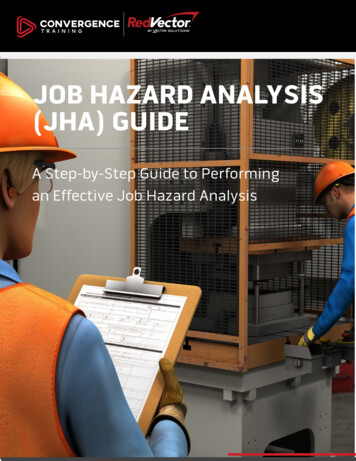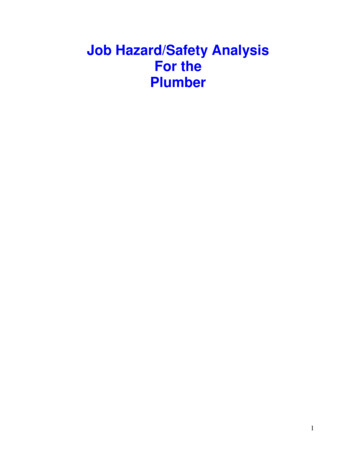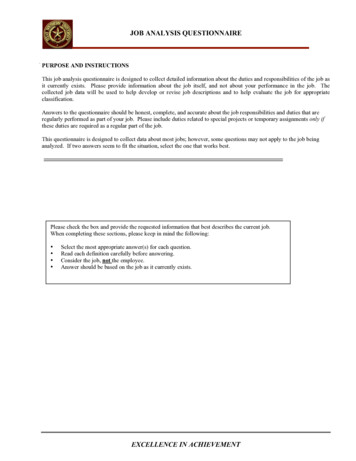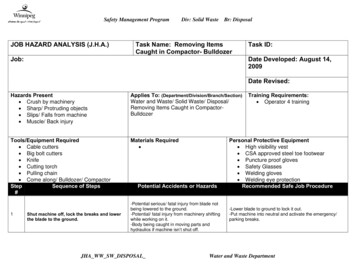
Transcription
Safety Management ProgramJOB HAZARD ANALYSIS (J.H.A.)Job:Div: Solid WasteBr: DisposalTask Name: Removing ItemsCaught in Compactor- BulldozerTask ID:Date Developed: August 14,2009Date Revised:Hazards Present Crush by machinery Sharp/ Protruding objects Slips/ Falls from machine Muscle/ Back injuryApplies To: (Department/Division/Branch/Section)Water and Waste/ Solid Waste/ Disposal/Removing Items Caught in CompactorBulldozerTools/Equipment Required Cable cutters Big bolt cutters Knife Cutting torch Pulling chain Come along/ Bulldozer/ CompactorStepSequence of Steps#Materials Required 1Shut machine off, lock the breaks and lowerthe blade to the ground.Potential Accidents or Hazards-Potential serious/ fatal injury from blade notbeing lowered to the ground.-Potential/ fatal injury from machinery shiftingwhile working on it.-Body being caught in moving parts andhydraulics if machine isn’t shut off.JHA WW SW DISPOSALTraining Requirements: Operator 4 trainingPersonal Protective Equipment High visibility vest CSA approved steel toe footwear Puncture proof gloves Safety Glasses Welding gloves Welding eye protectionRecommended Safe Job Procedure-Lower blade to ground to lock it out.-Put machine into neutral and activate the emergency/parking breaks.Water and Waste Department
Safety Management Program2Div: Solid Waste-Slipping on mud, ice, steel-Back injury or muscle strain from a fall-Being cut or impaled by hard/sharp/protruding landing surfaces when fallingDismount machineBr: Disposal-Clear mud off ladder steps (summer).- Use sand on machine ladder steps (winter).- Dismount machinery slowly; refrain from using quickjerky movements.- Ensure footing is solid before proceeding to nextmounting step.- Grip handles tight, with full fist.Lock out machine and survey what/ howitems need to be removed from machine.-Other people starting machine and drivingmachine unknowing to worker in/ undermachine area.-Falling off machine/ knocking limbs frompulling items out of machine that were loose inthe first place.3Pull or cut small cables in machine by hand,or;4-Cutting hands/ fingers with tools.-Cut or puncture to skin by cables/ springs/sharps from pulling material.-Cables/ springs poking eyes when pulling.-Material pulling out and hitting worker in theface.-Muscle/ back injuryJHA WW SW DISPOSAL-Find master cut off switch on machine, near engine bay,turn the key to the off position and remove it beforesurveying.-Look and asses to see how items need to be removed, orhow stuck they might be.-Gently pull and wiggle stuck items to evaluate if theymight need to be taken out a different way.-If material (cables, springs, etc.) wont move, do notattempt to pull harder or to keep pulling. Move on toanother option of removal.-Wear all personal protective equipment.-Avoid from jerky/ abrupt pulling movement.Water and Waste Department
Safety Management ProgramDiv: Solid WasteBr: DisposalPull large items or cables out of machine bydozer/ come-along/ front-end loader with achain, or;5-Falling into/ off of machine parts whenattaching chain.-Chain/ cables snapping when pulling, causingsevere injury to workers standing in vicinity.-Being hit by heavy machinery-Sand steps (winter)-Maintain a three point contact when climbing machine.-Ensure good solid footing when attaching chain tomaterial.-Stand far back or on the other side of the inactivemachinery, out of the way to avoid from being hit by chain.-Maintain eye contact at all times with other machineryoperators.-Ensure only the equipment mechanic uses the cuttingtorch, and only if necessary.-Ensure there are no leaks from machinery or the cuttingmaterial is not extremely flammable before cutting.-Wear all personal protective equipment.6Have equipment mechanic cut large cableswith cutting torch if necessary-Explosion if torch contacts flammablematerials.-Burns to mechanic from torch.-Damaging machinery from torch.7Going under machinery to remove caughtitems-Puncture to skin from protruding/ sharparticles in ground.-Worker being crushed by machine.Climbing machine to access/ pull caughtitems in machinery by hand.-Slipping off machine steel surfaces.-Falling onto protruding objects in ground-Falling behind blade area causing seriousinjury-Material dislodging causing operator to fall offmachine8JHA WW SW DISPOSAL-Ensure the machine is OFF, the breaks are locked, andthe machine is locked-out before going under machine.-Bring machine to mechanic bay or onto pavement ifpossible before going under machine.-Sand steps (winter)-Maintain a three point contact when climbing machine.-Ensure good solid footing when attaching pullingmaterial.-If material (cables, springs, etc.) wont move, do notattempt to pull harder or to keep pulling. Move on toanother option of removal.Water and Waste Department
Safety Management ProgramDeveloped By:Mgmt Co-ChairApproval:Brian RoachOriginal Signed By:Div: Solid WasteDuncan MenziesWorker Co-ChairApproval:Br: DisposalJim RoseOriginal Signed By:The information in this procedure does not take precedence over applicable government regulations, with which all employees should be familiar.JHA WW SW DISPOSALWater and Waste Department
Safety Management ProgramJOB HAZARD ANALYSIS (J.H.A.)Job:Div: Solid WasteBr: DisposalTask Name: Operating the ScaleTask ID:Date Developed: July 15, 2009Date Revised:Hazards Present Cold/ wet weather conditions Irate customers Pinch from window Slips on steel walkway Emotional Stress from scale operationtasks Unknown public entering scale office Back strain Repetitive MotionTools/Equipment Required Two forms of functionaltelecommunicationStep #12Sequence of StepsWalk from transport vehicle/ main officeto scale office.Collect fees from public through paymentwindow.*Continued on next pageApplies To: (Department/Division/Branch/Section)Water and waste/ Solid Waste/ Disposal/Operating the ScaleMaterials Required Sand for ice Salt for icePotential Accidents or HazardsTraining Requirements: Weighmaster trainingPersonal Protective Equipment High visibility vest Appropriate clothing for weather conditions CSA approved steel toe footwearRecommended Safe Job Procedure-Slipping on stairs or steel scale weigh area.-Being struck by vehicle traffic.-Frostbite from exposure to cold weather.-Ensure a high visibility vest is worn.-Sand/ salt ground frequently where workers may walk.-Wear proper clothing for weather conditions.-Back strain from bending out of window-Exposure to weather elements (wind, rain,cold)-Verbal abuse or threats from irate public-Physical violence from public through windowor coming through main office door.-Advise public to exit vehicle and come up to window if theypark too far from window, DON’T REACH for them.-Wear proper clothing for weather conditions-If public becomes irate, close and lock both windows thencontact foreman to notify them of the situation.-Push the red button hard and slowly to open the windowJHA WW SW DISPOSALWater and Waste Department
Safety Management Program3456Div: Solid WasteBr: Disposal-Window snapping back and pinching fingersor arm.-Unknown persons entering scale officethrough access door.-Muscle strain from extending left arm throughwindow frequently.-Restricted line of sight towards road.-Ensure the door to the scale office is locked at all times-Alternate arms when collecting fees through the window.-Suggest engineering controls such as surveillancecameras or mirrors to allow for better line of sight towardsincoming vehicles.-Back strain from bending out of window-Exposure to weather elements (wind, rain,cold)-Verbal abuse or threats from irate public-Window snapping back and pinching fingersor arm-DON’T REACH for public, let them get out of their car orreach for you.-If public becomes irate, close and lock both windows thencontact foreman to notify them of the situation-Push the red button hard and slowly to close the windowExit scale office to direct traffic off scaleor into alternate payment lanes.-Freezing temperatures in winter-Slipping on ice or steel ground in winter-Being struck by vehicular traffic-Use intercom to explain usage of payment lane whenpossible.-Ensure a high visibility vest is worn-Wear proper clothing for weather conditions-Lock the door to the scale office after leaving scale office.- Sand and salt the ground in winter.-Ensure a second weighmaster is in the scale office toallow access through door, and to supervise in case ofemergency.Walk across payment lanes to instructpublic how to use automated paymentmethod.-Falling under the wheel of a moving vehicle-Tripping on curbs that separate lanes-Slipping on steel from the scale-Injury from falling at different heights whenwalking over lanesWalk back into scale office from directingtraffic or giving instruction to public-Being struck by vehicular traffic-Slips on ice or steel stepsReturn receipt and give instruction topublic through window.JHA WW SW DISPOSAL-Walk to the end of the payment lanes to enter fromopening of the lane.-Salt and sand payment lanes prior to shift and occasionallythroughout the day.-Walk on salted/ sanded path-Ensure that drivers of vehicle see you before crossinglanesWater and Waste Department
Safety Management Program7Exit scale office to transport vehicle orwalk back to main office.Developed By:Mgmt Co-ChairApproval:Div: Solid Waste-Slipping on stairs or steel scale weigh area.-Being struck by vehicle traffic.-Frostbite from exposure to cold weather.Brian RoachOriginal Signed By:Doug ReidBr: Disposal-Ensure a high visibility vest is worn.-Wear proper clothing for weather conditions.-Sand/ salt ground frequently where workers may walk.Jim CarterWorker Co-ChairApproval:Original Signed By:The information in this procedure does not take precedence over applicable government regulations, with which all employees should be familiar.JHA WW SW DISPOSALWater and Waste Department
Safety Management ProgramJOB HAZARD ANALYSIS (J.H.A.)Job:Div: Solid WasteBr: DisposalTask Name: Operating Front-EndLoaderTask ID:Date Developed: Aug 7, 2009Date Revised:Hazards PresentSlips off machine’s ladderMachine malfunctionTipping machineApplies To: (Department/Division/Branch/Section)Water and waste/ Solid Waste/ Disposal/Operating Front-end LoaderTools/Equipment RequiredFront-end LoaderMaterials Required Step#Sequence of StepsTraining Requirements: Front-end Loader OperatorCertificationPersonal Protective EquipmentHigh Visibility VestCSA Approved Steel Toe FootwearPotential Accidents or HazardsRecommended Safe Job ProcedurePerform pre-trip inspection on the machine.-Machine malfunction if inspection isn’t doneproperly.12Mount the front-end loader-Slipping off the machine’s ladderJHA WW SW DISPOSAL-Locate master cut-off switch near the engine bay andensure it is on, check all fluid levels, inspect for wear andtear in fluid lines, tires, and joints of the machine.-Maintain a three point contact when climbing ladder.Water and Waste Department
Safety Management ProgramDiv: Solid WasteBr: Disposal-Mount the ladder slowly, avoid from using jerky/ abruptmovements.Start the machine and then travel to theload area3-Bucket catching on something on the groundand abruptly stopping the machine.-Operator being thrown around the cab of themachine from bumps or abrupt stops.-Striking objects or structures in path-Machine rocking back and forth severely intravel.-Raise the bucket to at least 18-24” off the ground and curlthe bucket up prior to travelling.-Wear seatbelt.-Ensure objects are clear of travel path and motion range ofthe machine.-Don’t travel with the bucket lifted higher than the front of themachine.-Machine falling into holes or ditches fromdriving up parallel to the side or at an angle.-Machine impacting the load pile fromapproaching too quickly-Approach holes/ ditches/ dips head on-Use the bucket to help stabilize the machine if it seemsunsteady, lower and press the bucket to the ground.-Advance into the load pile slowly, and raise the bucket outof the load pile slowly.Advance the machine towards the materialand scoop a load with the bucket.45Transport the load to the dumping area.JHA WW SW DISPOSAL-Transport load 18-24” above the ground.Water and Waste Department
Safety Management ProgramDiv: Solid Waste-Machine tipping forwards from the load in thebucket lifted too high.-Machine tipping from an abrupt stop whilecarrying load.67Raise the bucket to desired dumping heightand dump the load from the bucket in adesignated dumping area. Continue theloading and dumping process until job iscomplete.-Machine tipping forward from lifting andstopping machine at the same time.-Striking other equipment with the bucket inlift.-Other people being buried by the load.-Vibration from machine/ long periods of sittingcausing vascular/ musculoskeletal disorders.Drive the front-end loader to its parkingarea, lower bucket to the ground, shutdown the machine, then dismount.-Bucket catching on something on the groundand abruptly stopping the machine.-Machine rocking back and forth severely intravel.-Slipping off the machine’s ladder-Avoid abrupt stops, or sharp turns in travel.-Begin to slow down well before the dumping area.-Lift the bucket when the machine has slowed down orstopped.-Ensure that personnel are clear of the dumping area.-Take small breaks and walk around to circulate blood flowand move body parts.-Raise the bucket to at least 18-24” off the ground prior totravelling the front-end loader.-Don’t travel with the bucket lifted higher than the front of themachine.-Maintain a three point contact when climbing ladder.-Dismount the ladder slowly, avoid from using jerky/ abruptmovements.-Locate the master cut-off switch near the engine bayand turn it off.-Engage the hydraulic lever in the cab, on the right side ofthe seat.Perform post-trip inspection and lock outthe machine.8Br: Disposal-Fatal/ serious injury to other workers ifmachine isn’t locked out properly.-Machine malfunction from wear and tear thatgoes undetected.-Perform a full post-trip inspection and report anyquestionable or suspicious looking defects on the machineto the landfill foreman.JHA WW SW DISPOSALWater and Waste Department
Safety Management ProgramDeveloped By:Mgmt Co-ChairApproval:Brian RoachOriginal Signed By:Div: Solid WasteJim RoseBr: DisposalKen TaylorWorker Co-ChairApproval:Original Signed By:The information in this procedure does not take precedence over applicable government regulations, with which all employees should be familiar.JHA WW SW DISPOSALWater and Waste Department
Safety Management ProgramJOB HAZARD ANALYSIS (J.H.A.)Job:Div: Solid WasteBr: DisposalTask Name: Finding and Cutting Fire Task ID:WoodDate Developed: August 17, 2009Date Revised:Hazards Present Sharp tools Flying wood Splinters Nails in wood Hepatitis or TetanusTools/Equipment RequiredFull size axeSwede SawChain sawStep#Applies To: (Department/Division/Branch/Section)Water and Waste/ Solid Waste/ Disposal/Finding and Cutting Fire Wood.Materials RequiredSequence of StepsTraining Requirements:Landfill helper trainingChain saw trainingPersonal Protective EquipmentHigh Visibility VestCSA approved ankle-high steel toe footwearLeather GlovesSafety GlassesLong denim pantsPotential Accidents or HazardsRecommended Safe Job Procedure-If patrons are dumping wood, direct them to dump it next tothe shelter hut.-If wood has run out completely, call foremen to request aid inlocating more wood for immediate burning.-Wear all personal protective equipment (gloves, etc.)-Avoid from venturing into the refuse, grab wood that is in theopen and easily accessible.-Survey the wood for any nails/ staples before picking it up,1Walk to nearby area and look for wood-Twisting ankle/ slips/ trips from uneven walkingground.-Being struck by vehicle/ large mobile equipmenttraffic.2Grab and carry wood back to shelter hut(handling wood)-Puncture to skin from nails or sharps whilesorting in the refuse area.-Slivers/ cuts from sharp edges of wood.-Muscle/ Back strain from lifting heavy woodJHA WW SW DISPOSALWater and Waste Department
Safety Management ProgramDiv: Solid Wastethen flip the wood over from it’s edge to look for nails/ staples.-Avoid using pallets or large pieces of wood, but if necessary,request assistance when lifting them.(pallets, wet wood).3456Br: Disposal-Back/ Muscle strain from lifting/ swinging axe.-Swinging axe and missing the target, resultingin hitting legs/ feet.-Flying pieces of wood hitting legs/ abdominalarea.-Wood chips flying into eyes.-Keep focused when cutting wood, do not look away when inthe downswing of the cut.-Keep feet parallel to the outside of the wood piece, and keepa wide stance.-Place wood on another log piece for better stability.-Avoid hyper extending the spine when raising the axeoverhead and contract abdominal muscles.Sawing wood-Severe laceration/ cut to skin.-Cut to legs from the saw coming through thewood after the cut.-Severe injury occurring from attempting to forcea stuck saw blade.-If cut severely, apply pressure to wound, apply emergencyfirst aid, and call and ambulance or have foreman transportinjured worker to hospital.-Hold wood about 12” away from the saw blade.-Do not attempt to force the blade to cut if it gets stuck, lift thewood up from the bottom with your free hand, and keepcutting slowly.Removing nails from refuse wood-Punctures/ cuts to skin-Possibly contracting hepatitis or tetanus frombeing cut by nails.-Survey the wood for any nails/ staples before picking it up,then flip the wood over from its edge to look for nails/ staples.-Wear leather gloves.-Hammer the pointy side of the nail (hammer the nail “out”),then pry the nail out from the other side with the hammer.Handling wood once cut-Back/ muscle strain from handling wood.-Slivers/ cuts from sharp wood.-Other people injuring themselves from nails stillstuck in wood.-Lift with legs, hold wood close to the body, bend knees torelease load.-Discard wood with nails, if nails couldn’t be removed.Chopping wood with axeJHA WW SW DISPOSALWater and Waste Department
Safety Management ProgramDeveloped By:Mgmt Co-ChairApproval:Brian RoachOriginal Signed By:Div: Solid WasteBr: DisposalJames CarterWorker Co-ChairApproval:Original Signed By:The information in this procedure does not take precedence over applicable government regulations, with which all employees should be familiar.JHA WW SW DISPOSALWater and Waste Department
Safety Management ProgramJOB HAZARD ANALYSIS (J.H.A.)Div: Solid WasteBr: DisposalTask Name: : Directing traffic incommercial and residential dumpingcellsJob:Task ID:Date Developed: July 15, 2009Date Revised:Hazards Present Extreme Hot/ Cold Weatherexposure Wind Dust particulates Uneven/ Unstable Ground Being Struck by Large MobileEquipment (Garbage Trucks) Potential low visibility Trip hazardsTools/Equipment Required Shelter Hut Half ton truck for shelter (truck withair conditioning on hot day) SandStep #1Applies To: (Department/Division/Branch/Section)Water and waste/ Solid Waste/ Disposal/Directing Traffic in Commercial and ResidentialDumping CellsMaterials Required Two-way radioSequence of StepsDrive up to dumping cell(s)Personal Protective Equipment High visibility vest CSA approved ankle high steel toe footwear CSA approved safety glasses Appropriate clothing for weather conditionsPotential Accidents or HazardsRecommended Safe Job Procedure-Serious vehicular accident from loss of controlon gravel road.-Collision with other traffic-Vehicle sliding into ditchJHA WW SW LETraining Requirements: Traffic director training-Do not exceed the speed limit of 50Km/H-Drive slower than speed limit in winter conditions-Don’t hug the middle of the road, stay on your side.-Don’t try to avoid potholes or large puddles, drive throughthem slowly.Water and Waste Department
Safety Management Program23Park in dumping cell(s)Exit vehicle to enter shelter hutDiv: Solid Waste-Being struck by large mobile equipment-Collision with other vehicles from low visibility-Drive uphill to the cell slowly; remain on one side of the road,not in the middle.-Ensure headlights are on in low visibility conditions.-Twisting ankle or slipping on the unstable,slippery, uneven walking ground-Tripping on articles protruding from ground- Walk slowly.- Ensure you are visible to others by wearing a high visibilityvest.- Limit walking distance from transport vehicle to shelter hut.- Stay clear of other machinery and other vehicular traffic.Exit vehicle or shelter hut to directtraffic456Direct dumping vehicles to designateddumping area(s).Venture throughout cell area to directtraffic.Br: Disposal-Twisting ankle or slipping on the unstable,slippery, uneven walking ground-Tripping on articles protruding from ground-Being struck by large mobile equipment-Walk slowly-Sand steps of shelter hut to reduce slippery surface-Ensure there is at least one other landfill helper available onsite to watch the traffic director in the field, in case ofemergency.-Being struck by large mobile equipment-Freezing/ frostbite in cold weather temperatures-Dust blowing into eyes-Breathing in dust and other particulate matter-Heat stroke or exhaustion from exposure tohigh UV rays and hot/ humid temperature-Wear high visibility vest-Use large movements when directing traffic to appear morevisible to traffic.-Wear clothing that will protect against the elements of rain,wind, extreme cold.-Hydrate regularly by drinking water-Wear a hat and sunscreen in hot/ humid weather conditions-Wear safety glasses.-Being struck by large mobile equipment-Being dumped on from disposal trucks-Stay 20 meters back when walking behind large mobileequipment.-Make visual contact with drivers before proceeding to walkbeside or behind large mobile equipment (If you can’t seethem, they can’t see you).-Avoid the need for venturing close to disposal trucks*Picture on next pageJHA WW SW LEWater and Waste Department
Safety Management Program78Walking back to shelter hut or sheltervehicle.Drive back to main office at break orend of shift.Developed By:Mgmt Co-ChairApproval:Div: Solid Waste-Twisting ankle or slipping on the unstable,slippery, uneven walking ground-Tripping on articles protruding from ground-Being struck by large mobile equipment-Walk slowly-Sand steps of shelter hut to reduce slippery surface-Avoid the need for venturing close to disposal trucks-Serious vehicular accident from loss of controlon gravel road.-Collision with other traffic-Vehicle sliding into ditchBrian RoachOriginal Signed By:Br: Disposal-Do not exceed speed of 15KmH on the roads to the dumpingcells.-Do not exceed the speed limit of 50Km/H on main gravelroad.-Drive slower than speed limit in winter conditions-Don’t hug the middle of the road, stay on your side.-Don’t try to avoid potholes or large puddles, drive throughthem slowly.Ryan TuckJames CarterWorker Co-ChairApproval:Original Signed By:The information in this procedure does not take precedence over applicable government regulations, with which all employees should be familiar.JHA WW SW LEWater and Waste Department
Safety Management ProgramJOB HAZARD ANALYSIS (J.H.A.)Div: Solid WasteBr: DisposalTask Name: Digging and filling theanimal waste pitJob:Task ID:Date Developed: August 4, 2009Date Revised:Hazards Present Machine/ operator falling into hole Heavy machinery striking operator Constant vibration from machineTools/Equipment Required Functional two-way radio or cellphone Metal bar for scraping mud off tracks Shovel Excavator machineryStepSequence of Steps#Applies To: (Department/Division/Branch/Section)Water and waste/ Solid Waste/ Disposal/Digging and Filling the Animal Waste PitTraining Requirements: Excavator operator training Traffic director training WHMIS trainingMaterials RequiredPersonal Protective Equipment Sand for traction when mounting/ High visibility vestdismounting machine. Ankle high CSA approved steel toe footwear Clothing for extreme cold weather. Rubber/ latex glovesPotential Accidents or HazardsRecommended Safe Job ProcedureMount the excavator1-Slipping off steps/ tracks from mud/ ice.-Falling from height onto protruding objects inground.-Muscle strain while mounting excavator.JHA WW SW Disposal-Mount machine from the step in between the tracks, thenstep on tracks, all while grasping the handle next to the doorof the excavator.-Sand the step/ tracks prior to mounting machine for bettertraction (winter).-Mount machinery slowly; refrain from using quick jerkymovements.-Ensure good footing on steps when mounting.Water and Waste Department
Safety Management ProgramDiv: Solid WasteDrive to the desired area to beginexcavation for an animal waste pit-Excavator falling/tipping into previously dughole (s).-Striking other large mobile equipment.-Objects in path causing a more hazardoustravel path.2Br: Disposal-Survey driving path prior to travelling to the pit area, toensure for a clear path.-Ensure any surrounding large machinery know of yourposition from visual and radio contact.-Approach holes or dips in the ground with the tracks facingtheir direction.Begin digging a hole 10-15’ deep, 10’ wideand 30’ long. Add to the length of the holein increments.345-Always face the machine’s tracks towards the pit for easyescape if it collapses.-Call for help on the radio or cell phone if excavator falls/ tipsin hole:-Do not attempt to climb out of excavator or hole if you havefallen in, call for help and wait until it arrives.-Unknown objects (cables, pipes, tanks) inground being punctured/ snapping, causingprojectile to hit cabin on excavator.-Excavator tipping/ falling into hole.Drive excavator out of animal pit area,park and turn machine off, then dismountexcavator to direct dumping vehicle.Direct dumping vehicle towards animalpit.-Slipping and falling off tracks from mud/ ice.-Machine tipping into hole-Slipping/ falling into animal pit.-Being hit by reversing vehicle.-Being buried by the load being dumped.-Frostbite from extreme cold.JHA WW SW Disposal-Sand the steps prior to dismounting the machine (winter)-Dismount machinery slowly; refrain from using quick jerkymovements.-Stand at least three meters from the pit at all times.-Ensure eye contact with the driver of the dumping vehicle atall times.-Never stand directly behind the dumping vehicle.-Wear warm insulating clothes/ gloves/ hat etc (winter).Water and Waste Department
Safety Management Program678Mount excavator after dumping vehicleleaves the area, then drive to animal pit tobegin burying waste in the hole.Approach the pit from its long side, andbegin to bury the exposed animal waste.Drive to the desired excavator parkingarea, and dismount excavator.Div: Solid Waste-Slipping off steps/ tracks from mud/ ice.-Falling from height onto protruding objects inground.-Muscle strain while mounting excavator.Br: Disposal-Mount machinery slowly; refrain from using quick jerkymovements.-Ensure good footing on steps when mounting.-Excavator falling into hole from the holecollapsing.-Always face the machine’s tracks towards the pit for easyescape if it collapses.-Slipping off steps/ tracks from mud/ ice.-Falling from height onto protruding objects inground.-Machine tipping into hole-Sand the steps prior to dismounting the machine (winter)-Dismount machinery slowly; refrain from using quick jerkymovements.-Extreme weather conditions (cold, heat, rain)-Slipping and striking the tracks with body.-Muscle/ back strain.-Excavator storage door swinging back andhitting/ crushing operator’s hands.-Wear warm insulating clothes/ gloves/ hat etc.-Wear leather gloves in summer.-Avoid jerky movements when scraping the tracks.-Ensure a solid footing when scraping the tracks.-Hold excavator storage door open with one hand when it iswindy.Clean tracks of excavator.9Clean boots/ tools, parts of machinerywith SRM disinfectant liquid.10-Spraying liquid into eyes-Getting liquid into mouth or onto skinJHA WW SW Disposal-Ensure the Material Safety Data Sheet is easily accessibleincase of exposure to disinfectant liquid.-Flush eyes with water for 15 minutes if liquid splashes intoeyes.-Wear safety glasses and rubber/ latex gloves.Water and Waste Department
Safety Management ProgramDeveloped By:Mgmt Co-ChairApproval:Brian RoachOriginal Signed By:Div: Solid WasteBr: DisposalDenis (RothesayEmployee)Worker Co-ChairApproval:Original Signed By:The information in this procedure does not take precedence over applicable government regulations, with which all employees should be familiar.JHA WW SW DisposalWater and Waste Department
Safety Management ProgramJOB HAZARD ANALYSIS (J.H.A.)Div: Solid WasteBr: DisposalTask Name: Covering Fires in theDumping Cells with a Bulldozer/CompactorJob:Task ID:Date Developed: August 10,2009Date Revised:Hazards Present Hazardous fumes/ gases from burninggarbage. Explosion from fire Burns to skin Equipment catching fire Subsurface fire potentialTools/Equipment Required Bulldozer with blade Compactor with blade ScraperStepSequence of Steps#1Begin the following process immediately andthen notify the foreman of the situation.Applies To: (Department/Division/Branch/Section)Water and waste/ Solid Waste/ Disposal/Covering Small Fires in the Dumping Cells witha Bulldozer-CompactorMaterials Required Mud/ Clean fill Fire extinguisherPotential Accidents or Hazards-Extremely hazardous fire situation resulting inlandfill employee’s seriously/ fatally injured.-Foreman ending up in a collision or runningcar off the road by rushing to the fire site.JHA WW SW DISPOSALTraining Requirements: Bulldozer/ Compactor OperatorCertificationPersonal Protective Equipment High visibility vest Leather gloves CSA approved steel toe footwearRecommended Safe Job Procedure-Foreman should visually inspect the situation.-Do not continue with this process if you feel your health/safety might be jeopardized by attempting to douse thefire.-Call the fire department (911) if there is ANY suspicion
JOB HAZARD ANALYSIS (J.H.A.) Task Name: Removing Items Caught in Compactor- Bulldozer Task ID: Job: Date Developed: August 14, 2009 Date Revised: Hazards Present Crush by machinery Water and Waste/ Solid Waste/ Disposal/ Sharp/ Protrud
